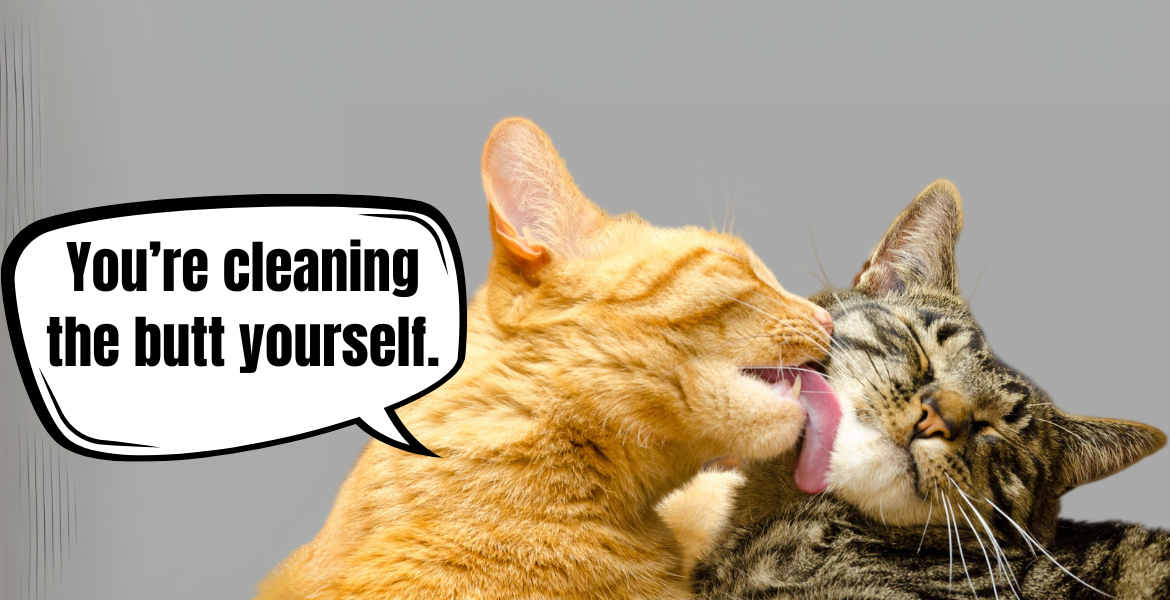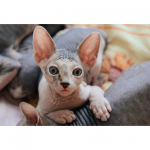At first glance, it looks like the picture of perfect friendship: two cats sharing a spot on their favorite scratching post, grooming each other’s fur. It must be a sign that they are best buddies, right? Well… not necessarily. And it doesn’t mean that one cat thinks the other could knock out everyone within a 100-meter radius with their smell either. Do you want to find out what roles mutual grooming plays in cat groups, fabCat? The reasons for this behavior might not be as obvious as you think.
A Childhood Memory
A mother cat teaches her kittens the basics of grooming from the first hours of life when she licks their fur clean, helps them with their physiological needs, and calms them with her presence. This behavior creates a special bond between the mother and her kittens and allows the entire cat group to adopt a common, “family” scent. Naturally, the little kittens imitate their mother and over time, they begin to groom not only their fur but also that of their siblings. This is an important element of early socialization, significantly influencing the cat’s later behavior, their attitude towards other animals, and even humans. This is evident in cats that grew up without a mother or siblings – these furballs often don’t know the boundaries between play and harm because they simply didn’t have the chance to learn them from a young age. They might also have trouble communicating with other cats when they have to share space with a feline friend in adulthood.
When a Cat Grooms Another Cat: What Does It Mean?
The significance of mutual grooming among adult cats varies depending on the situation the cats find themselves in and their relationship. If the cats get along well, are close, and regularly spend time together without fighting over resources, their mutual grooming of each other can be a simple sign of closeness. It is in these types of relationships that we can see a return to childhood – cats associate mutual grooming with the sense of security their mother provided and continue this tradition with pleasure in their relationships with their feline crew.
Another equally positive explanation for mutual grooming is the desire to support another cat. Cats are almost self-sufficient when it comes to hygiene, but have areas on their bodies that are harder to reach with their tongue. When they get down to business on their own, they often lick their paw and then use it to clean their ears or face. However, if a feline friend wants to help and the cat doesn’t mind – why not take advantage? Again, the element of building a common group scent and strengthening bonds within the cat group returns. In cat grooming, it’s never just about clean fur 🙂
So far, everything sounds pleasant, right? Unfortunately, mutual licking between cats can also have a dark side, and one of them is the fight over resources and the desire to show superiority in the cat group hierarchy. According to studies on cat behavior, the “stronger” cat, dominant in their group, will more often groom the “weaker” one to show them their place. For cats, this is a mild form of aggression – without harm to the other cat but showing “who’s the boss.” When will you observe such behavior? For example, during a fight over a favorite scratching post, bed, or spot on the windowsill. When one cat is resting on the scratching post, and the other desperately wants to take it over, they might jump on top and lick the sleeping buddy, clearly indicating “Get off, this is my spot.” Sometimes, if the other cat doesn’t want to give in or doesn’t accept the messages, it can lead to paw fights. Similar situations can occur around food bowls or the litter box, which is why it’s so important for each cat to have free access to all necessary resources, regardless of how well the cats get along with each other.
For more information on how to equip a home space for more than one cat, check out our blog: https://blog.mykotty.pl/en/2023/03/27/dont-be-selfish-share-how-to-furnish-a-house-for-more-than-one-cat/
How Can You Use This Knowledge, fabCat?
Knowing the reasons why your cats might engage in mutual grooming will make it easier for you to interpret the messages your furballs are sending to you and each other. Such knowledge is essential in the repertoire of a fabCat Caretaker. It’s not a big deal to live with a cat group when everyone gets along smoothly. The real challenge starts when you notice that the affections between your purring darlings start to take the form of pushing and shoving.
If you catch early on that one cat is regularly chasing the other from corner to corner, that’s the best moment to react. Don’t wait until mutual, forced grooming turns into more aggressive behaviors. Increase the number of resources the cats can use. Create a cat-friendly environment so the furballs can move around the house and use the entire available space without stepping on each other’s toes. And if the problem intensifies and becomes a daily occurrence, consult a behaviorist.
There is no rule that cats that get along once will live in harmony forever. Be sensitive to small changes in cat behavior, fabCat, and keep expanding your knowledge to better understand the needs of your furballs. You deserve to be the best Caretaker for them 🙂




